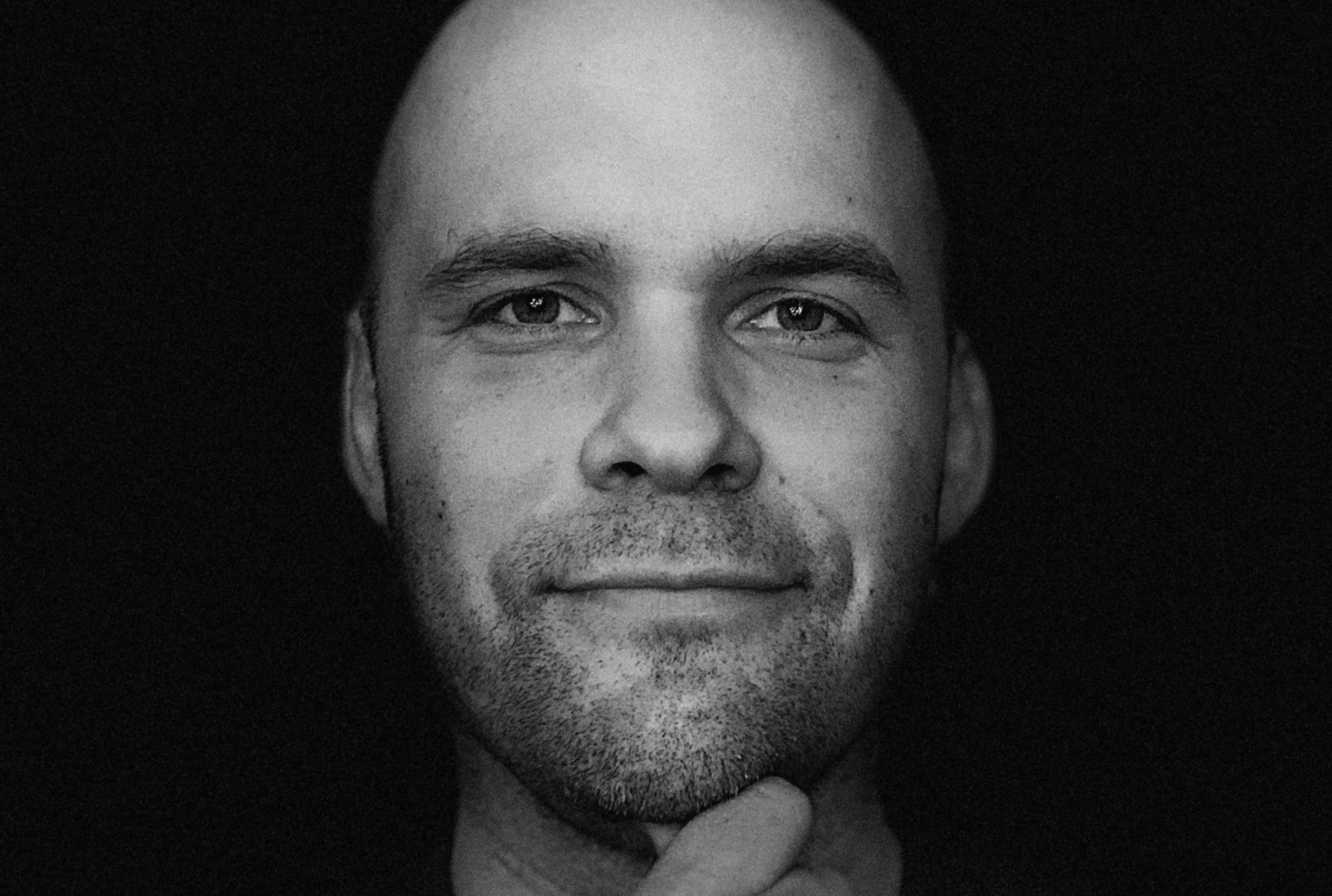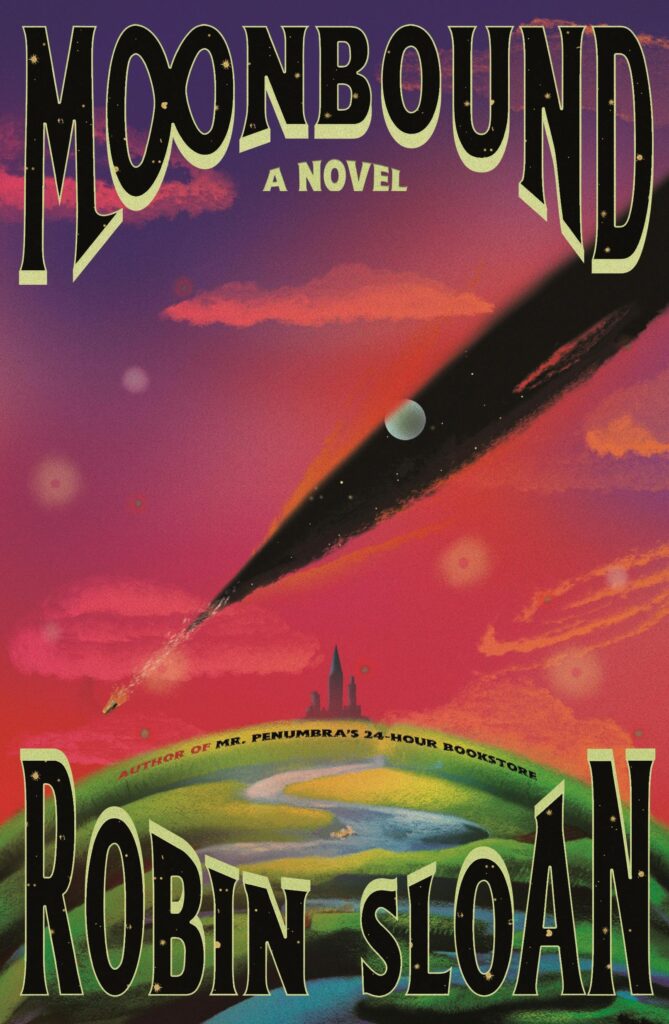Robin Sloan‘s third novel, Moonbound, launched in June, is a fantasy story that takes place within the deep science-fiction future—no fewer than 11,000 years therefore. It’s additionally a narrative about tales, wealthy with quests, synthetic intelligence, and multiple hero’s journey.
The legend of Arthur looms giant, not less than till Moonbound’s protagonist, a boy in a realm dominated by a wizard, elects for an alternate path. It unfolds in a future to which the previous has despatched tales, hoping to reverse the troubling course historical past has adopted. That quandary manifests as one more story, about dragons on the moon, that has plunged what stays of humanity into worry. The novel builds on themes, akin to highly effective tomes and sentient fungi, from Sloan’s earlier novels—his debut, the New York Occasions bestseller Mr. Penumbra’s 24-Hour Bookstore, and Sourdough are each set within the Bay Space—such that Moonbound’s cowl publicizes it as the newest within the “Penumbraverse.”
Sloan, an Oakland resident, is a outstanding presence in San Francisco literary life, usually interviewing authors coming by city on the commerce winds of their newest publications. Wired just lately named him “the tech world’s best dwelling novelist.” He spoke with 48 Hills through what old-school scifi referred to as a “video cellphone,” aka Zoom. Because the dialog started, Sloan pointed over his shoulder to the traditional Risograph printer on which he printed the nifty zine he snail-mailed to individuals who pre-ordered Moonbound.
We proceeded to speak about, amongst different matters: uninformed protagonists, the applied sciences of narrative, and San Francisco’s double-helix bond with the longer term. The next has been edited for readability and size.
48 HILLS I noticed you learn at a current SF in SF occasion along with your fellow novelists Rudy Rucker and Clara Ward. Whereas Rucker spoke, you stroked Moonbound‘s cowl, which options embossed parts. From the e-book’s glyphs to its opening map, to not point out your Risograph zine, it’s clear you’re into the e-book as an object. May you speak a bit about that physicality?
ROBIN SLOAN Whereas I all the time recognized as somebody who likes books, I didn’t actually perceive the potential for expression in that object till I linked up with my longtime writer, FSG, for all three novels, particularly my editor, Sean McDonald. I dunno if he’s ever stated this, however I’ll simply paraphrase his vibe: within the twenty first century, if you’ll make a print e-book, you’ve acquired to make it price folks’s time. This began with my first novel, Mr. Penumbra’s 24-Hour Bookstore. They confirmed me some sketches for the quilt and stated, “Wherever you see that actually shiny yellow colour, that’ll glow at the hours of darkness.” And I used to be like, “I didn’t know that was an choice.” From that time onward, there’s been an actual sense of play. The area of the digital has grown and grown, which has made it really feel extra pressing to spend time on bodily artifacts.
48 HILLS Moonbound reveals that beavers talk by the buildings they construct, so the thought of bodily objects expressing that means is true there in your story, proper?
ROBIN SLOAN I usually consider the eloquence of the bodily, and that takes plenty of totally different kinds, however considered one of them germane to this dialogue. A digital e-book, an article that you just’re studying on the 48 Hills web site, any type of book you purchase in your Kindle—all of them have the identical property: They go quietly into the evening as quickly as they scroll off that web page. It’s nonetheless there, however you’ve acquired to go dig for it, and sometimes you don’t. You simply overlook it’s there as a result of one thing else has changed it within the infinite feed. A bodily e-book is stubbornly asserting its existence. It sounds easy, virtually glib, however that bodily object, the bodily e-book, can try this: can sit on a shelf or in your desk and go, “Hey, keep in mind me?” That’s highly effective, now greater than ever.
48 HILLS: Moonbound’s narrator is an AI referred to as a “chronicler” that embeds itself into the consciousness of different characters. The AI has its personal perspective, plus an unlimited database of historical past, all whereas folding in info from the individuals it’s been biologically certain to. How did that narrative machine come to be?
ROBIN SLOAN I’m sincerely glad to listen to folks report it really works. I used to be assured however I wasn’t 100% positive. Technically, in craft phrases, that’s the a part of the e-book I’m the proudest of. It took tinkering and improvement to get there. In a method, it was me fixing an issue I’d recognized for myself. My earlier two novels have been written within the first particular person. I’ve all the time cherished that, as a author and a reader. The alternatives for humor are better in case you have a powerful perspective. Nonetheless, over time, I turned extra conscious of the constraints. I feel it turns into extra extreme in a fantastical or science fictional mode as a result of it’s annoying to be caught with a personality who doesn’t know something. You get bored with “Wow, what’s that?” “Whoa, what are they doing?” It’s like, come on, someone’s acquired to know one thing. It seems in fiction, it’s enjoyable when folks know issues and have opinions about them.
48 HILLS A giant a part of Mr. Penumbra is that the primary character doesn’t know something. That format works nicely as a result of he’s an clever character, however virtually everybody else within the e-book is aware of greater than the narrator does.
ROBIN SLOAN: Yeah, and that e-book was solely medium bizarre. There are clearly different choices. It’s my opinion that the full-on third particular person, the old school omniscient narrator, is tough to do intellectually slash politically within the twenty first century. It’s enjoyable however there’s no escaping this query of who the hell is that this purported to be?
And it’s enjoyable that the chronicler is “diegetic,” you can say: It’s not simply literary expertise; it’s truly science-fictional expertise. It’s an strategy that arose out of the story, which additionally gave me these literary instruments. It’s an embodied first particular person, with opinions and a perspective. It’s additionally that traditional restricted third particular person narrator on the character’s shoulder. And it’s the encyclopedia, a contact of omniscience, as a result of even when the chronicler doesn’t know every part concerning the world they’re in, it is aware of concerning the universe and what’s attainable. I felt like I had an issue to unravel, and I’m actually proud of the answer that I discovered my strategy to.
48 HILLS Although I haven’t counted, I’d say there could also be extra semicolons in Moonbound than in your earlier two novels mixed. There are conventional semicolons, like the place two sentences join for causes that individuals who don’t like semicolons can’t actually take care of. However plenty of occasions within the e-book, semicolons are doing their very own factor. Are you able to discuss your semicolon journey?
ROBIN SLOAN: I’ve gotten extra assured with punctuation. I used to sweat it, worrying about—air quotes—correct utilization. Perhaps it’s all of the writing I’ve finished on-line. Sending lengthy newsletters has been coaching. You strive various things. I’m completely comfy with virtually arbitrary deployment of not solely semicolons, however colons and em-dashes. I really like that I don’t know if I might articulate my very own principle of utilization, however it’s not arbitrary.
The factor that I feel is essentially the most unhinged that I do—and that due to this fact I like essentially the most—is the double colon. Often you might be, like: phrase, colon, factor that explains that phrase. However typically it’s not sufficient. So that you go: phrase colon phrase one other colon: To me it feels proper. If I needed to write down the algorithmic guidelines for it, I couldn’t. It’s locked up within the aesthetic matrix of my mind. However I can’t be stopped. That is nice to recollect: the chance nonetheless and all the time exists to invent new usages. It’s freaking superior.
48 HILLS: It is a query you’ve been requested variations of because the e-book got here out, and I must ask a variation of it myself. In Mr. Penumbra, the Google worker, Kat, talks concerning the issue of imagining the far future. She estimates: “We run out of analogies within the thirty-first century.” But you pushed forward 11,000-plus years. How arduous was it?
ROBIN SLOAN: It was troublesome. And it goes to indicate it has been a preoccupation of mine. That begins, I feel, as a science fiction reader myself. Actually credit score goes to the San Francisco–based mostly Lengthy Now Basis, which has been a significant enter. Just like the mid-2000s for me, particularly, listening to geologists type of simply dance throughout time, thousands and thousands of years—it was actually formative stuff. That tees up the curiosity. However then, yeah, how do you do it? And for me, it’s prefer it’s pushing in from each side. On one aspect, you wish to rise to the problem. You wish to push past the form of “close to future”: Sure, it’s now, besides everybody wears a trench coat and it’s raining on a regular basis. Which is enjoyable. I adore it.
However you’re like, let me go additional and weirder, and what does that imply? As an example, anyone who thinks about that for greater than two seconds realizes it’s acquired to take critically the non-human, proper. It may possibly’t simply be the way forward for people as a result of that’s not the total future at these timescales. In order that’s pushing from one path. There’s a counterforce, although, from the opposite path: the calls for of with the ability to inform a narrative in any respect. It will be cool and fascinating to put in writing a e-book about Earth 20 million years from now, however you truly couldn’t with out time journey.
48 HILLS: Did your creativeness hit partitions you needed to push by?
ROBIN SLOAN: The phrase “wall” doesn’t appear proper. To have enjoyable with analogies, I feel it was extra of a hike by a panorama—at sure factors, surmounting ridge strains and seeing these broad vistas.
48 HILLS: San Francisco performs a giant function in Moonbound, if not as central a job as in Mr. Penumbra and Sourdough. That far into the longer term, how did you discover your strategy to San Francisco—which within the e-book you describe as “the town the longer term reached again and made, as a result of it was going to be wanted.”
ROBIN SLOAN: It completely needed to. A broader engagement right here with the longer term is simply—you need to actually ignore all of the folks round you in San Francisco to not have that seep in. That’s been a strong affect on me. I took an amazing be aware from Kim Stanley Robinson’s novel The Ministry for the Future, which I cherished. In organising a scene, he writes, “San Francisco, essentially the most stunning metropolis on this planet.” He’s not attempting to persuade you. He’s simply telling you; it’s like “carbon, the sixth ingredient.” I freaking cherished that. I believed it was such a enjoyable transfer. So I actually do the identical factor. There’s a line the place a personality named Durga says, “San Francisco, essentially the most stunning metropolis on this planet.”
48 HILLS: After I reread Mr. Penumbra just lately, I used to be struck by its admiring tone relating to Google. It’s difficult to reread. Whereas the strategy doesn’t maintain as much as what occurred in actuality, it’s a fantastic amber capsule of an outdated perspective.
ROBIN SLOAN: I’ve come to think about it as a helpful time capsule. I hope someone writes a PhD thesis in one other 20 years, like “Textual Proof for the Altering Perceptions of Tech Mega Firms.”
48 HILLS: Alongside these strains, I appreciated the way you wrote in Moonbound about San Francisco bereft of the hate aimed toward this space by individuals who’ve usually by no means even been right here.
ROBIN SLOAN: I feel that is San Francisco’s burden, but additionally its reward: it’s not only a place; it’s a logo and a bizarre beacon. I all the time remind myself that the complaints and horror tales about San Francisco aren’t about an actual metropolis the place actual folks stay their each day lives, as a result of the folks making these arguments don’t need them to be.
Who is aware of what the longer term holds for San Francisco, or for the Bay Space, but when the previous is any indication—I imply, it’s that protean rise and smash, rise and smash, the enormous pistons on this engine: an financial engine, a cultural engine, an aesthetic engine. That’s what it’s all the time been, and what it’s all the time going to be. You’ll be able to’t have the rise with out the autumn. However I’ll say I’m among the many prime rank of the world’s nice San Francisco evangelists. I typically say San Francisco “patriots.” I’m a believer to my core.




